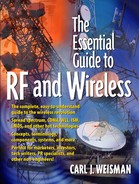DECIBELS
Definition
If mathematicians had never come along, the story might stop right here and you would be an expert on loss and gain. Unfortunately, however, the signals leaving a transmitter can be literally a billion times larger than the signals arriving at the receiver, and the multiplication and division of such disparate numbers can be quite unruly. So mathematicians came up with a way of representing these big numbers with smaller numbers, which allows the use of addition and subtraction in place of multiplication and division. They call this little trick logarithms. (Or, as some people affectionately refer to them, those nasty little things which nobody understood in Algebra.) Before you panic and throw out the book, logarithms (or logs) are really very simple. Trust me.
There are only two things you need to know about logs when used in the context of RF. First, logs are always a ratio of two values, and second, this ratio has units of decibels (named after some guy with the last name Bel—really). Decibels are also referred to in the industry as dB (pronounced d' b). For those of you who are gluttons for punishment, I have included the definition of dB here. Feel free to ignore it.
![]()
Decibel Math
As mentioned above, if the signal coming out of an amplifier is 100 times bigger than the signal going in, then the amplifier has a gain of 100, or using the definition above, the same amplifier has a gain of 20 dB. Before you start scurrying to find your high school calculator, let me make matters really simple. There are only two dB conversions you are ever going to need. Take my word for it.

There are also two corollaries (remember Geometry?) you will need to know. First, if the number gets smaller, the dBs are negative.

Second, dBs are only added or subtracted, they are never multiplied or divided. There, you're done. That is everything you need to know about logarithms and decibels. Now for a single illustrative example, see Example 2-1.
Now that you know how to do this conversion, you can forget it, as you will never need it again. The world of RF only deals in dB, so all you will ever have to do is add or subtract dBs at any point in the system to figure out what is going on.
Note: When a device exhibits loss, it is said to have a "loss of 6 dB." You must understand that this is equivalent to a change of -6 dB. It will not be referred to as a "loss of minus 6 dB."
Suppose there is the situation shown in Figure 2-3.
Example 2-1
A simple decibel conversion.
If a signal experiences a gain of 4000 (gets 4000 times bigger), what is the gain in dB?
It is best to break up the gain of 4000 into its simplest factors as shown below.
![]()
Now you simply replace the multiplication of factors by the addition of dB (from the only two that you know).
![]()
A gain of 4000 is equivalent to a gain of 36 dB. What if it were a loss of 4000 instead of a gain? Simple. A loss of 4000 is equivalent to -36 dB. What if it were a gain of 5000, how would you utilize the only two conversions you know? Be creative.

Figure 2-3. Totaling up the decibels.

An electrical signal at point A goes into component 1 with a loss of 2 dB, then goes to component 2 with a gain of 30 dB, then on to components 3 and 4 with losses of 7 dB and 1 dB, respectively. How big is the signal at point B with respect to the signal at point A? Has it experienced loss or gain? Since you are new at this, I will walk you through it, but in the future you are on your own.
The signal at point A minus 2 dB plus 30 dB minus 7 dB minus 1 dB equals the signal at point B. Therefore, the signal at point A plus 20 dB equals the signal at point B. Since 20 dB is being added to the signal at point A, the signal at point A gets bigger as it goes to point B, and therefore it experiences gain. In fact, it experiences exactly 20 dB of gain. Therefore, the signal at point B is 20 dB (or 100 times) bigger than at point A. If you understand this explanation, congratulate yourself, you have grasped a key element of RF.
But just to be sure, try one yourself. Referring to Figure 2-4, what is the size of the signal at point B with respect to the signal at point A?
Figure 2-4. A decibel test.

The answer is -10 dB (1/10th the size). An interesting thing to note is that the lines connecting the devices in Figures 2-3 and 2-4 also exhibit insertion loss. Most of the time the loss in these "lines" is small and insignificant compared to the loss in the actual components, so it is ignored, but you should be aware of it. When a signal at one point in the system is 10 dB smaller than a signal at another point in the system, the smaller signal is said to be "10 dB down" from the larger signal.
Did You Know?
Probably the most famous expression in all of RF is the term "3 dB down." When a signal is referred to as being "3 dB down" from some reference signal, it means it's half as big. Sometimes RF engineers use the expression jokingly like, "I need to get my weight 3 dB down." Funny, huh?
